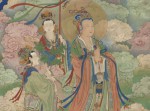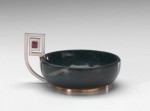Temples and Shrines in Japan exhibition features fifteen woodblock prints by Japanese artist Kawase Hasui. They were selected from more than 320 Hasui prints donated to VMFA by René and Carolyn Balcer in 2006. Created from 1924 through 1953, these works, which focus on scenes of temples and shrines across Japan, celebrate the architecture of sacred sites and their relationship with nature.
Hasui created more than six hundred woodblock color prints throughout his career. As an acclaimed painter and printmaker, he illustrated landscapes, townscapes, and sacred landmarks in Japan. He was named a Living National Treasure by the Japanese government in 1956.
Early in his career, Hasui worked primarily as a commercial illustrator for magazines and in advertising. His career path changed in 1918 when he was inspired by the prints of Ito Shinsui and began to create prints of his own. That same year, Hasui’s first experimental prints were published by Watanabe Shōzaburō, initiating a relationship that would last for the rest of Hasui’s life.
Watanabe named the prints created by Hasui and others shin-hanga, meaning “new prints.” By bringing together the talents of an artist, a block carver, a printer or block colorist, and a publisher, shin-hanga works mimicked the traditional collaborative process of ukiyo-e printmaking. Instead of the flat, stylized planes typical in ukiyo-e, shin-hanga incorporated aspects of Western draftsmanship and printmaking, including perspective and volumetric shading.
Event Has Concluded
East Asian Galleries Open this Month
Posted on September 12, 2012
On September 20, VMFA will celebrate the public opening of the new East Asian art galleries. The East Asian suite –... Read morePosted on April 4, 2012
More than two years ago, Virginia Museum of Fine Arts Director Alex Nyerges proposed to his curatorial staff a... Read more



